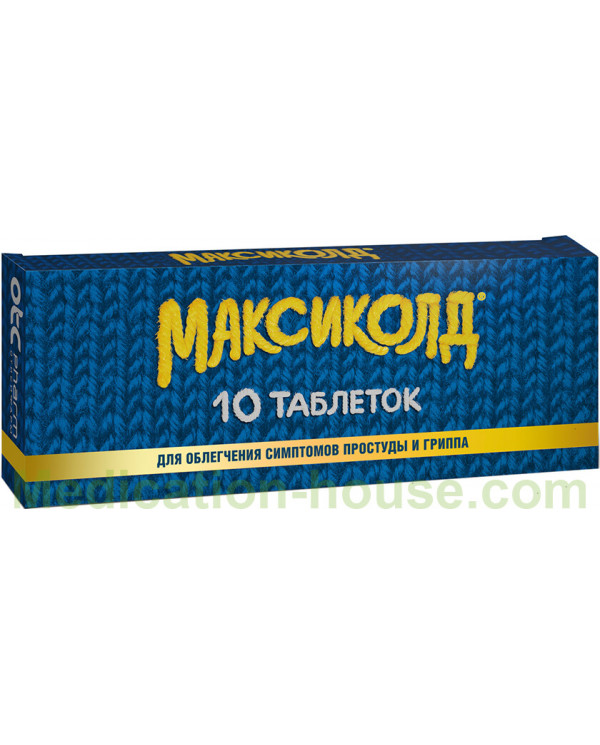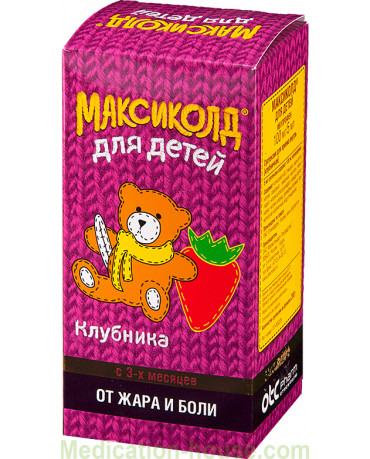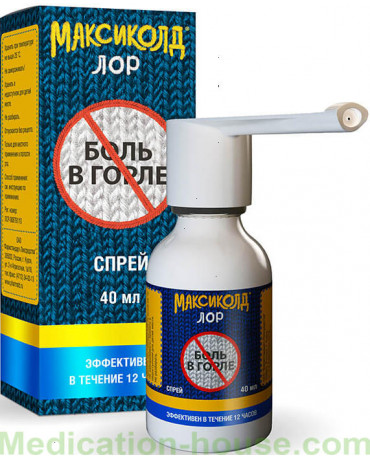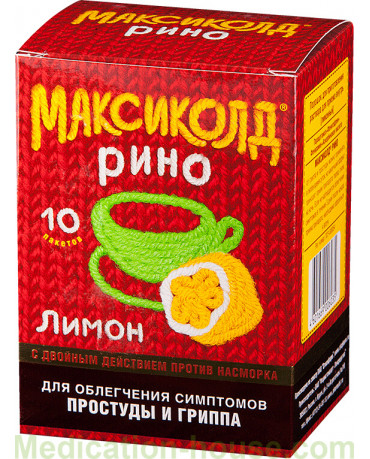Maxicold instruction
You can buy Maxicold here
Composition per tablet
Active substances: paracetamol - 500 mg, phenylephrine hydrochloride - 10 mg, ascorbic acid - 30 mg.
Excipients:
core: croscarmellose sodium - 28.00 mg, calcium hydrogen phosphate - 82.62 mg, ethyl cellulose - 0.20 mg, hyprolose (hydroxypropyl cellulose) - 35.00 mg, magnesium stearate - 7.00 mg, talc - 7.00 mg, dye sunny sunset yellow (E 110) - 0.18 mg;
shell: hypromellose (hydroxypropyl methylcellulose) - 13,200 mg, hyprolysis (hydroxypropyl cellulose) - 7,701 mg, talc - 6,300 mg, titanium dioxide - 2,750 mg, sunset sunset yellow (E 110) - 0,049 mg or OPADRY 20A230018 Orange (OPADRY 20А230018 Orange (OPADRY 20А230018 Orange) ) - 30.00 mg [Hypromellose (hydroxypropylmethyl cellulose) - 13,200 mg, hyprolose (hydroxypropyl cellulose) - 7,701 mg, talc - 6,300 mg, titanium dioxide - 2,750 mg, sunset sunset yellow (E 110) - 0,049 mg].
Description
The tablets Maxicold, covered with a film membrane of pinkish-orange color, are oval doubly convex with a risk. On a cross-section, the tablet is pinkish-orange in color with white and orange blotches.
Pharmacotherapeutic group: a remedy for eliminating the symptoms of acute respiratory diseases (ARI) and the common cold (analgesic non-narcotic drug + alpha-adrenergic agonist + vitamin).
Pharmacological properties
Maxicold has an antipyretic and analgesic effect, designed to relieve the symptoms of the common cold and flu.
The effect of Maxicold is due to the properties of its constituent components.
Paracetamol is a non-narcotic analgesic that has an antipyretic and analgesic effect due to the blockade of cyclooxygenase in the central nervous system and the effect on the centers of pain and thermoregulation. Reduces headaches and muscle aches, fever phenomena.
Phenylephrine - alpha1-adrenostimulator, little effect on beta-adrenergic receptors of the heart; not catecholamine. Causes narrowing of arterioles, due to which it reduces edema and hyperemia of the mucous membrane of the nasal cavity, facilitates breathing through the nose.
Ascorbic acid - increases the body's resistance to infections, makes up for the increased need for vitamin C for colds and flu.
Pharmacokinetics
Paracetamol: well absorbed in the intestine, the time to reach maximum concentration (Tmax) - 0.5-2 hours; connection with plasma proteins - 15%. It is metabolized in the liver with the formation of both active and inactive metabolites. The elimination half-life (T1 / 2) is 1-4 hours. It is mainly excreted by the kidneys in the form of metabolites - glucuronides and sulfates, 3% - unchanged.
Phenylephrine: After oral administration, phenylephrine is poorly absorbed from the gastrointestinal tract (GIT). It is metabolized with the participation of monoamine oxidase (MAO) in the intestinal wall and with the "first passage" through the liver. Phenylephrine bioavailability is low.
Ascorbic acid: Absorbed in the digestive tract (mainly in the jejunum). Tmax after oral administration - 4 hours. It easily penetrates into white blood cells, platelets, and then into all tissues; the highest concentration is achieved in the glandular organs, white blood cells, liver and lens of the eye; crosses the placenta. It is metabolized mainly in the liver to deoxy-ascorbic acid and then to oxaloacetic acid and ascorbate-2-sulfate. It is excreted by the kidneys, through the intestines, with sweat, breast milk in unchanged form and in the form of metabolites.
Indications
Symptomatic treatment of infectious and inflammatory diseases (including influenza and other acute respiratory viral infections (ARVI)), accompanied by fever, chills, nasal congestion, headache, pain in the bones and muscles, in the throat and sinuses of the nose.
Contraindications
Hypersensitivity to any component of Maxicold; severe renal / liver failure; hyperthyroidism (including thyrotoxicosis); heart disease (severe stenosis of the aortic orifice, acute myocardial infarction, tachyarrhythmia); arterial hypertension; simultaneous administration of tricyclic antidepressants, beta-blockers, monoamine oxidase inhibitors, including within 14 days after cancellation; the simultaneous use of other paracetamol-containing agents and agents to alleviate the symptoms of the common cold, flu and nasal congestion; prostatic hyperplasia; angle-closure glaucoma; children's age (up to 9 years, as well as children weighing less than 30 kg).
Use with caution
With a deficiency of glucose-6-phosphate dehydrogenase, with benign hyperbilirubinemia, during pregnancy and lactation, in old age.
Dosage and administration
Inside, before meals or 1-2 hours after eating, drinking plenty of fluids.
Adults and children over 12 years of age (body weight over 40 kg): 1-2 tablets every 4-6 hours. Multiplicity of admission is not more than 4 times a day with an interval of at least 4 hours.
Children aged 9 to 12 years (body weight over 30 kg): 1 tablet every 4-6 hours. Multiplicity of admission is not more than 4 times a day with an interval of at least 4 hours.
Maxicold is not recommended for use for more than 5 days as an anesthetic and 3 days as an antipyretic without consulting a doctor. If symptoms persist, consult a doctor.
DO NOT EXCEED THE SPECIFIED DOSE.
Side effect of Maxicold
Allergic reactions are possible (skin rash, flushing of the skin, urticaria, angioedema).
Paracetamol: hematopoiesis (anemia, thrombocytopenia, methemoglobinemia). Phenylephrine: headache, nausea, or vomiting; angina pectoris, bradycardia, shortness of breath, increase or decrease in blood pressure, palpitations, tachycardia, ventricular arrhythmia (especially when used in high doses), irritability, motor anxiety, allergic reactions.
Ascorbic acid: can cause irritation of the gastrointestinal mucosa, with prolonged use of large doses - nausea, vomiting, diarrhea, hyperacid gastritis, ulceration of the gastrointestinal mucosa; decreased capillary permeability (possibly worsening tissue trophism, increased blood pressure, hypercoagulation, the development of microangiopathies). It is also possible the occurrence of thrombocytosis, hyperprothrombinemia, erythropenia, neutrophilic leukocytosis, hypokalemia, glucosuria, inhibition of the function of the insular apparatus of the pancreas.
With prolonged use in doses significantly higher than recommended, the likelihood of impaired renal function (moderate pollakiuria, hyperoxaluria, nephrolithiasis, damage to the glomerular apparatus of the kidneys), increased excitability of the central nervous system, headache, and insomnia increase.
In case of adverse reactions, consult a doctor.
Overdose
In case of overdose, seek medical attention immediately, even if you feel well, as there is a risk of delayed signs of serious liver damage.
In case of an overdose, symptoms are usually due to exposure to high doses of paracetamol.
Symptoms: during the first 24 hours after administration - pallor of the skin, nausea, vomiting, anorexia, abdominal pain; impaired glucose metabolism, metabolic acidosis. Symptoms of liver dysfunction may appear 12-48 hours after an overdose. In severe overdose - liver failure with progressive encephalopathy, coma, death; acute renal failure with tubular necrosis (including in the absence of severe liver damage); arrhythmia, pancreatitis. Hepatotoxic effect in adults is manifested when taking 10 g or more.
Treatment: administration of SH-group donors and precursors of glutathione synthesis - methionine within 8-9 hours after an overdose and acetylcysteine - within 8 hours. The need for additional therapeutic measures (further administration of methionine, iv administration of acetylcysteine) is determined depending on the concentration of paracetamol in the blood, as well as the time elapsed after its administration.
Interaction with other drugs
Maxicold enhances the effects of monoamine oxidase inhibitors, sedatives, ethanol.
The risk of developing the hepatotoxic effect of paracetamol is increased while taking ethanol, hepatotoxic drugs, inducers of microsomal oxidation enzymes in the liver (phenytoin, barbiturates, rifampicin, phenylbutazone, tricyclic antidepressants, etc.).
The concomitant use of paracetamol in high doses increases the effect of anticoagulant drugs (decreased synthesis of procoagulant factors in the liver). Paracetamol reduces the effectiveness of uricosuric drugs.
Prolonged use of barbiturates reduces the effectiveness of paracetamol. Metoclopramide and domperidone increase, and colestyramine reduces the rate of absorption of paracetamol. Inhibitors of microsomal oxidation enzymes (including cimetidine) reduce the risk of hepatotoxic effects of paracetamol.
The simultaneous use of ethanol and paracetamol contributes to the development of acute pancreatitis. Long-term combined use of paracetamol and non-steroidal anti-inflammatory drugs increases the risk of developing “analgesic” nephropathy and renal papillary necrosis, the onset of end-stage renal failure. The simultaneous long-term administration of high doses of paracetamol and salicylates increases the risk of developing kidney or bladder cancer. Diflunisal increases the plasma concentration of paracetamol by 50% risk of developing hepatotoxicity. Myelotoxic drugs increase the hematotoxicity of paracetamol.
Phenylephrine reduces the hypotensive effect of diuretics and antihypertensive drugs (including methyldopa, mecamylamine, guanadel, guanethidine), and reduces the antianginal effect of nitrates.
Phenothiazines, alpha-blockers (phentolamine), furosemide and other diuretics reduce the hypertensive effect of pheniramine. Monoamine oxidase inhibitors (including fu rasolidone, procarbazine, selegiline), oxytocin, ergot alkaloids, tricyclic antidepressants, methylphenidate, adrenostimulants enhance the vasoconstrictor effect and phenylephrine arrhythmogenicity, against the background of hypertensin arterine. Ergometrine, ergotamine, methylergometrine, oxytocin, doxapram increase the severity of the vasoconstrictor effect of pheniramine.
Inhaled anesthetics (including chloroform, enflurane, halothane, isoflurane, methoxyflurane) increase the risk of severe atrial and ventricular arrhythmias. Thyroid hormones increase (mutually) the effect of phenylephrine and the associated risk of coronary insufficiency (especially with coronary atherosclerosis).
Ascorbic acid increases the concentration of benzylpenicillin and tetracyclines in the blood, reduces the effectiveness of heparin and indirect anticoagulants, increases the overall clearance of ethanol, which in turn reduces the concentration of ascorbic acid in the body, and reduces the therapeutic effect of antipsychotic drugs (antipsychotics) of phenothiazine derivatives, tubular aminocytabe reabsorb antidepressants.
With simultaneous use with acetylsalicylic acid, urinary excretion of ascorbic acid increases and excretion of acetylsalicylic acid decreases. Acetylsalicylic acid, oral contraceptives, fresh juices and alkaline drink reduce the absorption and absorption of ascorbic acid.
Ascorbic acid improves absorption in the intestines of iron preparations; increases the risk of crystalluria in the treatment of short-acting salicylates and sulfanilamides, slows down kidney excretion of acids, increases the excretion of drugs with an alkaline reaction (including alkaloids), reduces the concentration of oral contraceptives in the blood, and reduces the chronotropic effect of isoprenaline. With prolonged use or use in high doses, it can interfere with the interaction of disulfiram and ethanol, in high doses it increases the excretion of mexiletine by the kidneys.
Quinoline drugs, calcium chloride, salicylates, glucocorticoids, with prolonged use, deplete the reserves of ascorbic acid. Barbiturates and primidone increase urinary excretion of ascorbic acid.
Special instructions for Maxicold
Before taking Maxicold, you need to consult a doctor in case of concomitant use of metoclopramide, domperidone, colestyramine (due to the fact that metoclopramide and domperidone increase, and colestyramine reduces the absorption rate of paracetamol), anticoagulants (because the concomitant use of paracetamol in high doses increases the effect of anticoagulants medicines).
Taking Maxicold distorts the results of laboratory tests that evaluate the concentration of glucose and uric acid in plasma.
When using Maxicold for more than 5-7 days, peripheral blood counts and the functional state of the liver should be monitored.
The use of Maxicold during pregnancy is possible only as directed by a doctor.
TO AVOID TOXIC HAZARD OF THE LIVER, THE DRUG SHOULD NOT BE COMBINED WITH ADMINISTRATION OF ALCOHOLIC BEVERAGES, AND ALSO ACCEPTED TO PERSONS WITH CHRONIC ALCOHOLISM.
Maxicold does not adversely affect the performance of potentially hazardous activities that require special attention and quick reactions.
Release form
Film-coated tablets.
On 2, 10 or 12 tablets in a blister strip packaging from a film of polyvinyl chloride and aluminum foil printed varnished.
1 or 2 blisters with instructions for use in a pack of cardboard.
Storage conditions
In a dry place at a temperature not exceeding 25 ° C. Keep out of the reach of children!
Shelf life - 1 year. Do not use after the expiration date indicated on the package.
Terms of sell
You can buy Maxicold without a prescription.




